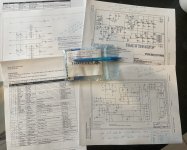See the classic aleph for UMS builder’s thread. Post #1 has an Aleph 30 build doc that will get you moving in the right track to build up your parts list.What type of resistor
See the classic aleph for UMS builder’s thread. Post #1 has an Aleph 30 build doc that will get you moving in the right track to build up your parts list.
I have the threads saved already.
So far, I have found 22-Ohms @ 5% from Mouser.
Edit: 20-Ohms @ 1% verses 22-Ohms @ 1%. Which gives me the best performance?
Edit: 20-Ohms @ 1% verses 22-Ohms @ 1%. Which gives me the best performance?
Last edited:
either of these will work:
https://www.mouser.com/ProductDetail/Vishay-BC-Components/SFR2500002009FR500?qs=LCMWAU1DZczh07eR/ZnM8w==
https://www.mouser.com/ProductDetail/YAGEO/MFR-25FTE52-20R?qs=oAGoVhmvjhzh/v5W/GeJFw==
read through the build guide if you haven't already
https://www.mouser.com/ProductDetail/Vishay-BC-Components/SFR2500002009FR500?qs=LCMWAU1DZczh07eR/ZnM8w==
https://www.mouser.com/ProductDetail/YAGEO/MFR-25FTE52-20R?qs=oAGoVhmvjhzh/v5W/GeJFw==
read through the build guide if you haven't already
Regarding drilling and tapping for the UMS pattern: I've done a full pattern for two amplifiers. For each amp and its pair of heat sinks, drilling takes a few hours, tapping same. If you break a drill bit or tap add 1/2-1 hour to the project. (easy to do in the M3 size). So about 3-4 hours of kinda-boring work.
So yes, it's asking a lot. Unless you have some experience with machining and are willing to spend a few evenings on this part of the project, buy the ready drilled/tapped heat sinks.
So yes, it's asking a lot. Unless you have some experience with machining and are willing to spend a few evenings on this part of the project, buy the ready drilled/tapped heat sinks.
So yes, it's asking a lot. Unless you have some experience with machining and are willing to spend a few evenings on this part of the project, buy the ready drilled/tapped heat sinks.
I will splurge for the ready-drilled heatsinks.
because it is in the middle of the range. 22 + 5% you have a chance to under snub. 18-5% you have a chance to over snub.It will take me a while to read it. But why settle for 20-Ohm when the max allowable is 22?
The snubber circuit reduces ringing in the transformer. When you get further along and have a decent idea of how the amp and power supply works, check out the quasimodo thread. Mark Johnson did a big article on it. A lot to digest especially as a new builder.
The Aleph comes in a bunch of different flavors. Aleph X, Aleph J. I think there is even an aleph with a vacuum tube in the circuit. Getting the amp built and understanding your aleph 30 is a great first step.
Last edited:
I downloaded your build PDF for the Aleph 30. Are there any parts differences that I need to be aware of for the classic build?
The part location names like R1 C1 etc may be different between the boards that you have and the boards that Peppe is sending you. But the schematic should be very close if not the same to the original aleph 30 schematic. Look at the Aleph 30 schematic and see if they match. You may have to do a little cross referencing.
Randy's boards are going to have a few more parts than the classic 30 like a jumper and some bypass caps.
Randy's boards are going to have a few more parts than the classic 30 like a jumper and some bypass caps.
The potentially tricky part will be cross referencing the original part numbering to BrianGT’s boards.
I have compared the original schematics (in your picture) against my PCB picture and it seems that this PCB iteration uses the original part numbering.
Peppe, I think those are Peter Daniel's boards and are based on the original Aleph 30 schematics.
Edit: I noticed the predrilled UMS store heatsinks were mentioned earlier. Note these PD boards most likely do not fit the UMS pattern since I believe they pre-dated that standard.
Edit: I noticed the predrilled UMS store heatsinks were mentioned earlier. Note these PD boards most likely do not fit the UMS pattern since I believe they pre-dated that standard.
Last edited:
That is correct. Those are PD boards but they look very similar to the BrianGT Aleph Mini/5/30 boards (picture below). The latter do not follow exactly the original part numbering.
I get confused myself about these boards. Actually, I don't even remember why I had both types in my drawer. I guess I have hoarded them back when group buys were the only way to get some.

I get confused myself about these boards. Actually, I don't even remember why I had both types in my drawer. I guess I have hoarded them back when group buys were the only way to get some.
- Home
- Amplifiers
- Pass Labs
- Chinese Pass amp clone
